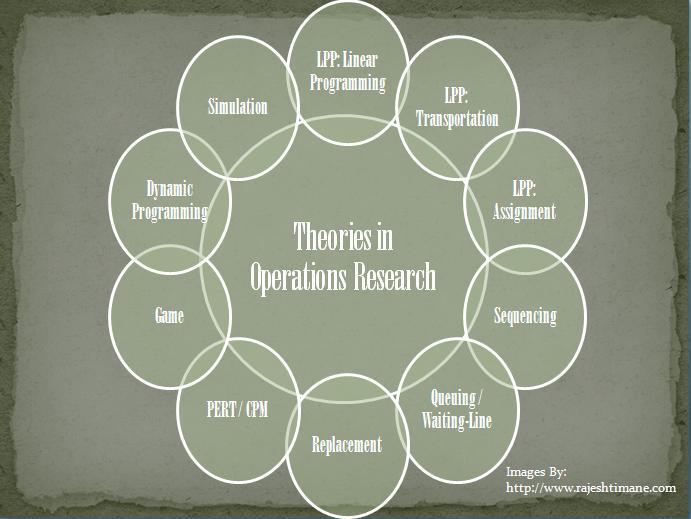In Operations Research, the nature and complexity of a model defines the type of method to be selected for the solution. There doesn’t exist one single general technique, which can solve the quantitative models arising out in everyday routines. Most techniques determine the solution by algorithms (repetitive iterations) instead of any closed form solutions. Discussed below are few of the popular Operations Research Techniques with a short description and applications thereof:
LPP: Linear Programming
Linear Programming is the method of choosing the best (optimal) alternative amongst the available (feasible) alternatives for either profit maximization or cost minimization, when the objective function and the constraints are mathematically expressed
Applications: Product-Mix, Scheduling, Routing, Facility Planning etc
LPP: Transportation
Distribution models help to determine the efficient transportation routes for moving the goods from factory / plants to different warehouses
Applications: Transport / Logistics Industry (Distribution / Warehousing)
LPP: Assignment
This is a variant of Transportation Model which provides the basis for optimal allocation of tasks to facilities at minimum cost or time
Applications: Allocating People, Jobs, Machines etc.
Sequencing
Sequencing models provide basis for the choice as to the ‘order in which multiple tasks can be performed’ in minimum duration
Applications: Aircraft Landings, Machining, Banking etc (Loading and Scheduling)
Queuing (Waiting Line)
The technique strikes an optimum balance between the costs of waiting against service-provided. It is the study of arrival of the customers for service, rate of providing service to customers and time spent by the customer in the line.
Applications: Waiting Lines (queue) formed anywhere
Replacement Theory
Whenever a new equipment offers better service-conditions than the existing one; replacement theory comes into picture. This theory concerns the forecasting of replacement costs and deciding the optimum replacement policy.
Applications: Purchasing decision about existing similar equipment
PERT / CPM
This involves listing the activities in a project, setting relationship, determining sequence and drawing schedule of these activities in order to minimize the overall time and cost of the project
Applications: Project Management, Scheduling (Infrastructure / Construction Industry…)
Games Theory
Games theory is concerned with Decision-Making in the conditions wherein multiple opponents are competing with conflicting interests towards winning. i.e. It deals with maximizing WINS or minimizing LOSSES before commencing of action.
Applications: Advertising / Sales Promotion / Branding etc
Dynamic programming
Dynamic Programming deals with relatively large and complex problems and involves sequencing of related decisions. It is a mathematical optimizing technique applied to multistage decision-making processes. It involves breaking a large problem into smaller ones’ and finding the solution by working backwards from end of the problem to the beginning.
Applications: Cargo loading, Bidding, EOQ, Traveling Salesmen Problem, Product Standardization…
Simulation
Simulation provides solution to the problems which are too expensive for experimental analysis and too complicated for mathematical treatment. To simulate means to imitate and experiment on the model of real-life phenomenon.
Applications: Inventory control, Queuing problems, Investment, Demand-Supply etc."
The above description of Operations Research was found at http://www.rajeshtimane.com/11/academics/operations-research-theories.html
LPP: Linear Programming
Linear Programming is the method of choosing the best (optimal) alternative amongst the available (feasible) alternatives for either profit maximization or cost minimization, when the objective function and the constraints are mathematically expressed
Applications: Product-Mix, Scheduling, Routing, Facility Planning etc
LPP: Transportation
Distribution models help to determine the efficient transportation routes for moving the goods from factory / plants to different warehouses
Applications: Transport / Logistics Industry (Distribution / Warehousing)
LPP: Assignment
This is a variant of Transportation Model which provides the basis for optimal allocation of tasks to facilities at minimum cost or time
Applications: Allocating People, Jobs, Machines etc.
Sequencing
Sequencing models provide basis for the choice as to the ‘order in which multiple tasks can be performed’ in minimum duration
Applications: Aircraft Landings, Machining, Banking etc (Loading and Scheduling)
Queuing (Waiting Line)
The technique strikes an optimum balance between the costs of waiting against service-provided. It is the study of arrival of the customers for service, rate of providing service to customers and time spent by the customer in the line.
Applications: Waiting Lines (queue) formed anywhere
Replacement Theory
Whenever a new equipment offers better service-conditions than the existing one; replacement theory comes into picture. This theory concerns the forecasting of replacement costs and deciding the optimum replacement policy.
Applications: Purchasing decision about existing similar equipment
PERT / CPM
This involves listing the activities in a project, setting relationship, determining sequence and drawing schedule of these activities in order to minimize the overall time and cost of the project
Applications: Project Management, Scheduling (Infrastructure / Construction Industry…)
Games Theory
Games theory is concerned with Decision-Making in the conditions wherein multiple opponents are competing with conflicting interests towards winning. i.e. It deals with maximizing WINS or minimizing LOSSES before commencing of action.
Applications: Advertising / Sales Promotion / Branding etc
Dynamic programming
Dynamic Programming deals with relatively large and complex problems and involves sequencing of related decisions. It is a mathematical optimizing technique applied to multistage decision-making processes. It involves breaking a large problem into smaller ones’ and finding the solution by working backwards from end of the problem to the beginning.
Applications: Cargo loading, Bidding, EOQ, Traveling Salesmen Problem, Product Standardization…
Simulation
Simulation provides solution to the problems which are too expensive for experimental analysis and too complicated for mathematical treatment. To simulate means to imitate and experiment on the model of real-life phenomenon.
Applications: Inventory control, Queuing problems, Investment, Demand-Supply etc."
The above description of Operations Research was found at http://www.rajeshtimane.com/11/academics/operations-research-theories.html


